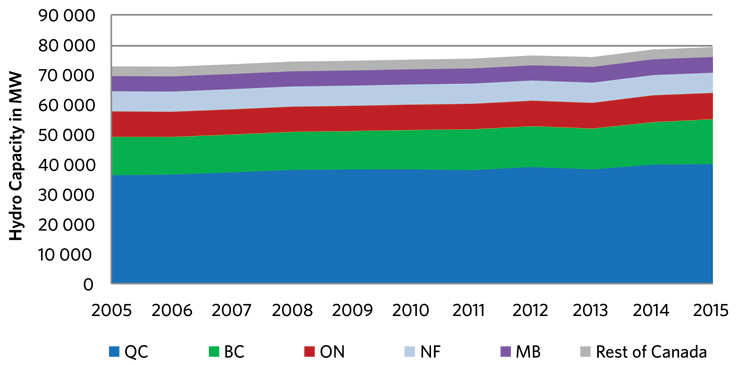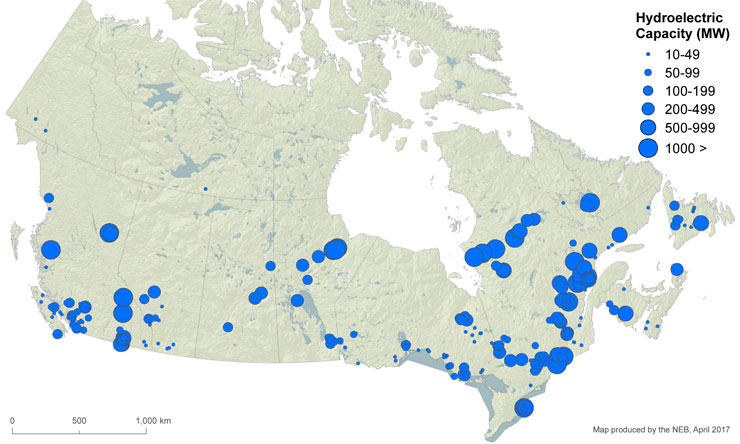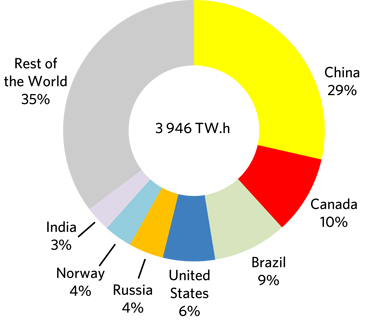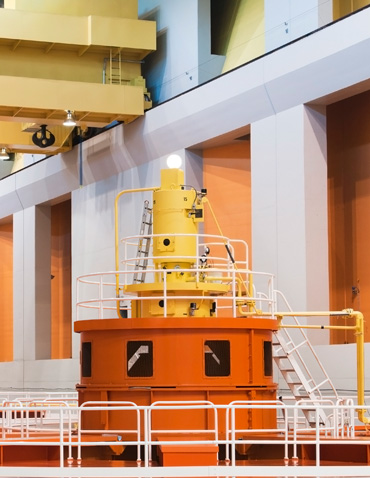ARCHIVED – Canada’s Adoption of Renewable Power Sources – Energy Market Analysis
This page has been archived on the Web
Information identified as archived is provided for reference, research or recordkeeping purposes. It is not subject to the Government of Canada Web Standards and has not been altered or updated since it was archived. Please contact us to request a format other than those available.
Hydro
Hydropower harnesses energy from moving water to activate a turbine connected to a generator. The amount of energy produced depends on water volume and speed: the more water moving at a fast rate, the more energy produced.
Hydropower plants vary in size and type. Projects are tailored to local conditions, and the technical feasibility of a potential hydroelectric site depends on the specific topography and climate.
Reservoir hydropower uses a dam to capture river water, which is then stored in a reservoir for release when needed. A deep, narrow valley with constructed walls and a dam that can support large volumes of water is an attractive site for this type of generation.
Reservoir hydropower can serve base load and peak demand through its ability to be shut down and started up at short notice. It can also offer enough storage capacity to operate independently of natural water flows for weeks, and even years. However, hydropower ultimately depends on precipitation patterns, which can be unpredictable.
Run-of-river hydro is built on an existing stream or river. Facilities are usually located where water naturally falls, for example, off a cliff or over rapids.
Recently developed turbines make it possible to operate run-of-river projects in sites with low flow and no height differences. The size of run-of-river facilities in Canada varies from less than 1 MW to almost 1 900 MW.
Pumped-storage hydropower moves water between reservoirs at different elevations. When electricity demand is low, electricity is used to pump water into a high reservoir. When demand peaks, water is released back into the lower reservoir through a turbine. The only pumped-storage facility in Canada is the Sir Adam Beck Pump Generating Station in Niagara Falls, Ontario.
Table 3 – Hydro Electricity in Canada: Key Statistics
| Key Statistics (2015) | Hydro |
|---|---|
| Installed capacity | 79 313 MW |
| Share of Canada’s capacity | 54.8% |
| Share of Canada's generation | 59.0% |
| Electricity generated | 385 500 GW.h |
| Generation growth from 2005 to 2015 | 8% |
Source: Canada’s Energy Future 2016: Update – Energy Supply and Demand Projections to 2040
Canadian Adoption
Hydroelectricity has been the main source of power generation in Canada for more than a century. British Columbia (B.C.), Manitoba, Quebec, Ontario, and Newfoundland and Labrador use hydro to meet most of their electricity demand. All provinces and territories produce hydroelectricity with the exception of Nunavut and PEI.
Several large hydroelectric projects are currently under construction. These include the 1 100 MW Site-C in B.C., the 695 MW Keeyask Project in Manitoba, two new generation units with a combined capacity of 640 MW at La Romaine in Quebec, and the 824 MW Muskrat Falls project in Labrador.
Figure 6 – Hydro Capacity in Canada

Source: Canada’s Energy Future 2016: Update – Energy Supply and Demand Projections to 2040
Description:
The stacked area chart shows hydroelectric capacity in five Canadian leading provinces and the rest of Canada between 2005 and 2015. The five provinces with the largest hydroelectric capacity are Quebec, B.C., Ontario, Newfoundland and Manitoba. In all those regions and the rest of Canada, hydroelectric capacity remained stable or grew slightly between 2005 and 2015.
Figure 7 – Map of Hydro Power Plants in Canada

Description:
This map shows the location and approximate capacity of hydro power plants with a capacity of at least 10 MW across Canada. Hydro facilities of this size can be found in every province and territory with the exception of PEI and Nunavut. Largest hydro facilities are located in B.C., Manitoba, Quebec, Ontario and Labrador, often in northern parts of those provinces.
International Adoption
Hydropower is used in over 150 countries and provided 16% of worldwide electricity in 2015. According to the International Hydropower Association, 33.7 GW of new capacity was installed in 2015 and 31.5 GWin 2016. This includes 6.4 GW of pumped storage, which is nearly twice the amount installed in 2015. China was the largest hydropower producer in the world, followed by Canada, Brazil, and the United States. Together, those four countries are responsible for about 50% of global hydropower output.
Environmental Considerations
Hydropower can help to balance intermittent renewable sources in an electricity grid, such as solar and wind, which allows for greater penetration of low GHG sources. It generates electricity without combusting fossil fuels. However, dams have fragmented nearly two-thirds of the world’s largest rivers, including many in Canada. Dams can interfere with fish migration, deplete oxygen in reservoirs, mobilize contaminants, and trap sediment that are important for maintaining downstream habitats including protecting deltas from erosion. New reservoirs typically create GHG emissions. However, this varies greatly depending on the vegetation, soils and preparation in the flooded area.
Because they do not use dams, run-of-river facilities cause fewer disturbances to fish and natural water flow when installed and operated according to specified limits.
Figure 8 – World Hydro Electricity Production in 2015

Source: BP World Energy Statistical Review
Description:
The donut chart shows hydro generation of the top seven producers and the rest of the world. The top seven hydro producers are China, Canada, Brazil, the United States, Russia, Norway and India. Together, they produce more than half of world's hydroelectric energy. Total global hydroelectric production in 2015 was 3 946 TW.h


Market Issues
Hydropower, especially large hydropower, is financially competitive with other electricity sources. Advantages include no fuel cost, low operating costs, and a very long and reliable service life. Hydropower also converts over 90% of available energy into electricity, whereas the most efficient combined cycle natural gas plants achieve approximately 60% efficiency.
On the other hand, hydropower projects can involve long construction periods and large upfront capital costs. Returns on investment may also vary greatly from year to year, depending on precipitation. These factors make it difficult for the private sector to invest in large hydro facilities, which is why they are usually built in Canada by provincial Crown Corporations (although smaller privately owned facilities do exist). The Canadian federal government has also provided financial support to hydroelectric projects, including a $6.3 billion loan guarantee for the Muskrat Falls generating station and associated transmission lines.
A major benefit of hydroelectricity is its reliability. In contrast to intermittent sources of renewable energy such as wind and solar, hydroelectric plants can produce electricity on demand and are recognized as system management assets capable of ensuring reliable supply.
Hydropower as an international supplement to wind
Norway generates about 95% of its electricity from hydro, the highest percentage among developed countries. With 29 GW of installed hydroelectric capacity, over half of Europe's hydropower is located in Norway. This hydropower is partially used as a “battery” to balance generation from intermittent renewables in other European countries. Norway trades electricity with Sweden, Finland, the Netherlands, and Denmark. Two additional interconnections in advanced stages of development will enable the exchange of surplus wind and solar power generated in Germany and the UK with hydroelectric power produced in Norway.
Similar examples of combining hydro and wind exist in North America. For example, the Quebec government recognizes the complementary nature of these sources, where hydro can support wind’s intermittency and wind can be dispatched to preserve energy stored in large hydroelectric reservoirs. The province already has significant hydroelectric capacity and through recent developments has installed 3 262 MW of wind capacity as of December 2015.

- Date modified:
